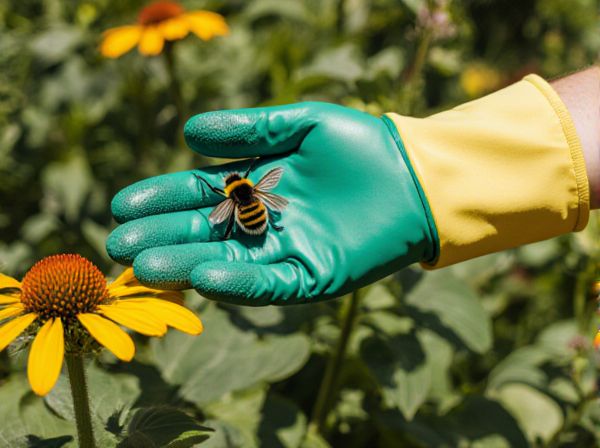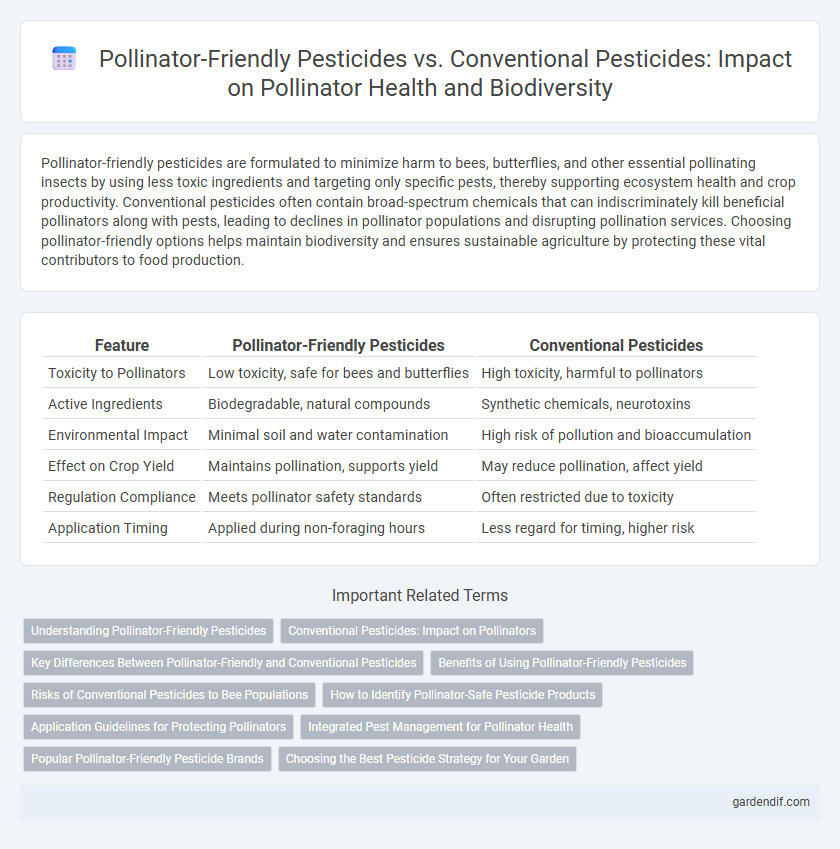
Pollinator-friendly pesticides vs Conventional pesticides Illustration
Pollinator-friendly pesticides are formulated to minimize harm to bees, butterflies, and other essential pollinating insects by using less toxic ingredients and targeting only specific pests, thereby supporting ecosystem health and crop productivity. Conventional pesticides often contain broad-spectrum chemicals that can indiscriminately kill beneficial pollinators along with pests, leading to declines in pollinator populations and disrupting pollination services. Choosing pollinator-friendly options helps maintain biodiversity and ensures sustainable agriculture by protecting these vital contributors to food production.
Table of Comparison
| Feature | Pollinator-Friendly Pesticides | Conventional Pesticides |
|---|---|---|
| Toxicity to Pollinators | Low toxicity, safe for bees and butterflies | High toxicity, harmful to pollinators |
| Active Ingredients | Biodegradable, natural compounds | Synthetic chemicals, neurotoxins |
| Environmental Impact | Minimal soil and water contamination | High risk of pollution and bioaccumulation |
| Effect on Crop Yield | Maintains pollination, supports yield | May reduce pollination, affect yield |
| Regulation Compliance | Meets pollinator safety standards | Often restricted due to toxicity |
| Application Timing | Applied during non-foraging hours | Less regard for timing, higher risk |
Understanding Pollinator-Friendly Pesticides
Pollinator-friendly pesticides are specifically formulated to minimize harm to essential pollinators such as bees, butterflies, and other beneficial insects by targeting pests with reduced toxicity and shorter residual effects. Unlike conventional pesticides, which often contain broad-spectrum chemicals that indiscriminately kill pests and beneficial species, pollinator-friendly alternatives incorporate biological agents, lower-risk chemicals, and application methods that avoid peak pollinator activity. Understanding these pesticides involves recognizing their ecological benefits, such as sustaining pollinator populations critical for crop pollination and ecosystem health, while effectively managing pest populations.
Conventional Pesticides: Impact on Pollinators
Conventional pesticides often contain neonicotinoids and organophosphates that are highly toxic to pollinators, causing lethal and sublethal effects such as impaired navigation, reduced foraging efficiency, and weakened immune systems in bees and butterflies. The widespread use of these pesticides correlates with significant declines in pollinator populations, disrupting essential ecosystem services like pollination of crops and wild plants. Residual pesticide contamination in soil, water, and pollen further exacerbates these impacts, leading to long-term threats to biodiversity and agricultural productivity.
Key Differences Between Pollinator-Friendly and Conventional Pesticides
Pollinator-friendly pesticides are formulated to minimize toxicity to bees, butterflies, and other essential pollinators by using compounds with lower persistence and targeted application methods, unlike conventional pesticides which often contain broad-spectrum chemicals harmful to non-target insects. These eco-conscious pesticides emphasize reduced exposure through lower application rates and timing that avoids peak pollinator activity, thereby supporting pollinator health and biodiversity. In contrast, conventional pesticides typically prioritize pest eradication without specific consideration for pollinator safety, contributing to pollinator population decline and ecosystem imbalance.
Benefits of Using Pollinator-Friendly Pesticides
Pollinator-friendly pesticides minimize harm to essential pollinators like bees, butterflies, and hummingbirds, ensuring the health of ecosystems and crop pollination. These pesticides reduce the risk of colony collapse disorder and support biodiversity by preserving beneficial insect populations. They contribute to sustainable agriculture by promoting safe pest control methods that protect pollinator habitats and enhance crop yields.
Risks of Conventional Pesticides to Bee Populations
Conventional pesticides contain harmful chemicals like neonicotinoids and organophosphates that pose significant risks to bee populations by impairing their navigation, foraging behavior, and immune systems. Exposure to these toxic substances leads to increased mortality rates and colony collapse disorders, drastically reducing pollinator diversity and abundance. In contrast, pollinator-friendly pesticides minimize chemical toxicity and environmental impact, promoting healthier ecosystems and sustaining vital pollination services.
How to Identify Pollinator-Safe Pesticide Products
Pollinator-safe pesticide products are identified by their reduced toxicity to bees, butterflies, and other beneficial insects, often labeled with certifications from organizations like the Pollinator Partnership or endorsements from environmental agencies. These pesticides typically use active ingredients such as spinosad, neem oil, or microbial agents that minimize harm to pollinators while effectively controlling pests. Checking product labels for pollinator protection claims and reviewing ingredient safety data sheets can help ensure the selection of environmentally responsible pest control options.
Application Guidelines for Protecting Pollinators
Pollinator-friendly pesticides require strict adherence to application guidelines that minimize exposure during peak pollinator activity, such as applying treatments early in the morning or late in the evening. These pesticides often have reduced toxicity and shorter residual effects compared to conventional pesticides, lowering the risk to bees and other beneficial insects. Proper buffer zones and avoiding application during blooming periods are critical steps to ensure the protection of pollinator populations.
Integrated Pest Management for Pollinator Health
Pollinator-friendly pesticides are specifically formulated to minimize toxicity to bees and other essential pollinators, supporting ecosystem health and crop yields. Integrated Pest Management (IPM) employs targeted application strategies and biological controls to reduce reliance on conventional pesticides, which often contain harmful chemicals that threaten pollinator populations. Implementing IPM enhances pollinator health by combining monitoring, threshold-based treatments, and habitat conservation to sustain biodiversity and ensure agricultural productivity.
Popular Pollinator-Friendly Pesticide Brands
Popular pollinator-friendly pesticide brands like EcoSMART, Serenade, and Monterey prioritize natural ingredients and reduced toxicity to protect bees and other pollinators while effectively managing pests. These brands utilize biofungicides, insecticidal soaps, and botanical oils that minimize harm to beneficial insects compared to conventional pesticides containing neonicotinoids or organophosphates. Integrating pollinator-friendly pesticides helps maintain biodiversity and supports sustainable agriculture by safeguarding vital pollinator populations.
Choosing the Best Pesticide Strategy for Your Garden
Pollinator-friendly pesticides prioritize protecting bees, butterflies, and other beneficial insects by using less toxic ingredients and applying treatments during times when pollinator activity is minimal, reducing harmful exposure. Conventional pesticides often contain neonicotinoids and organophosphates, which have been linked to pollinator decline due to their high toxicity and persistence in the environment. Selecting pollinator-friendly options and implementing integrated pest management (IPM) practices enhances garden health by balancing effective pest control with pollinator conservation.
Pollinator-friendly pesticides vs Conventional pesticides Infographic

 gardendif.com
gardendif.com